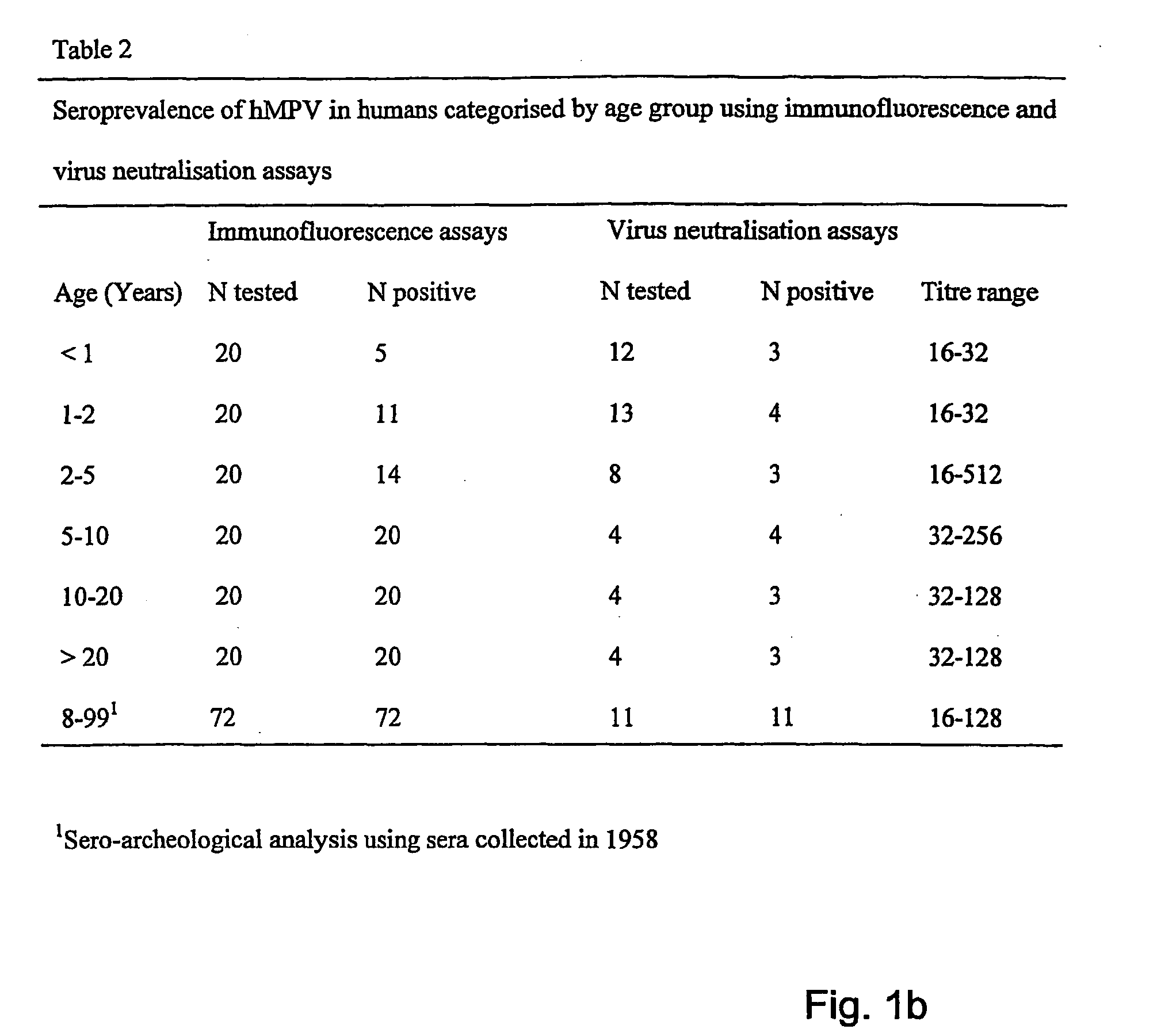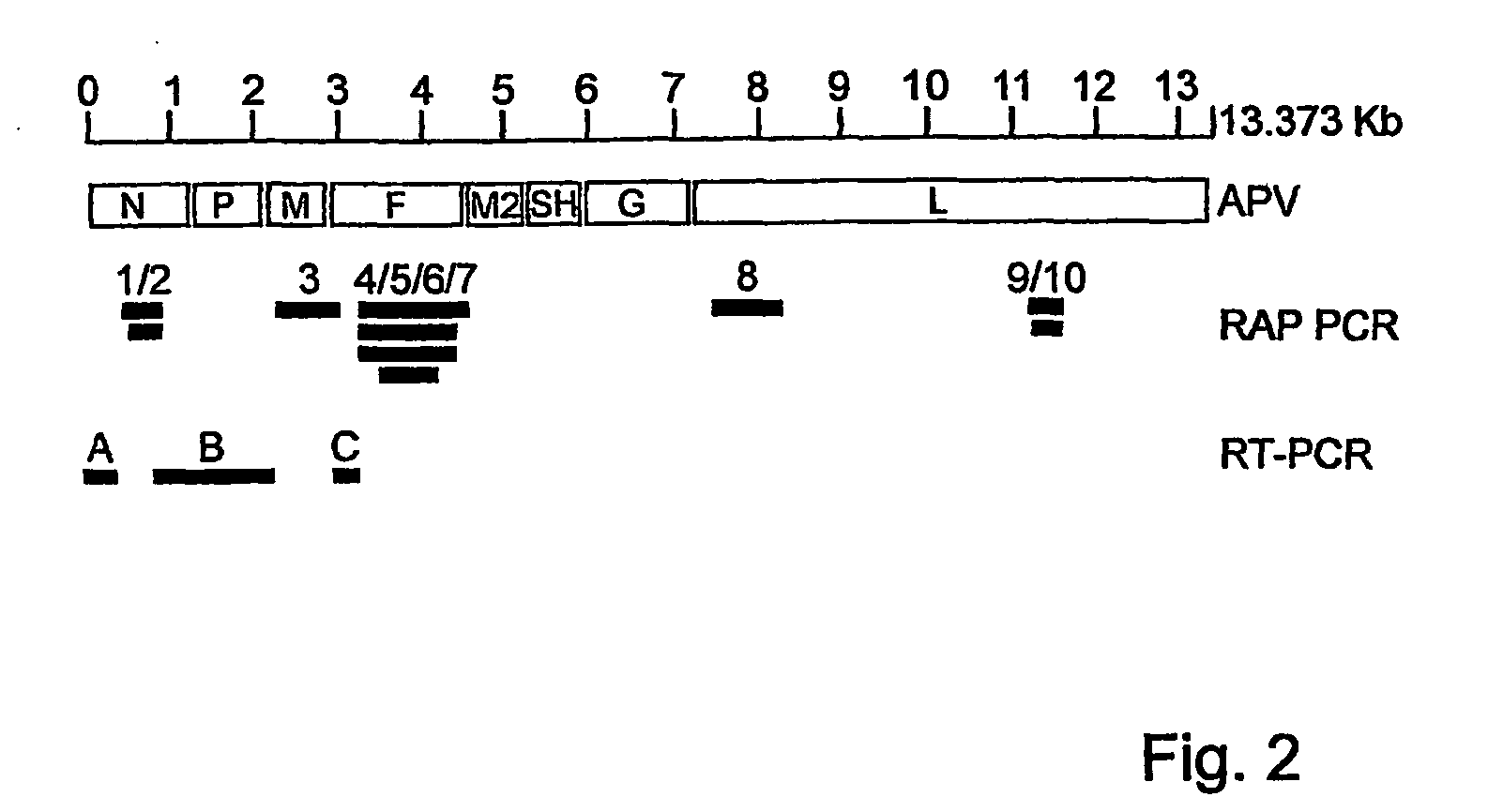Virus causing respiratory tract illness in susceptible mammals
a virus and respiratory tract technology, applied in the field of etiological agents of mammalian diseases, can solve the problems of low degree of sensitivity, high morbidity and variable, and high mortality
- Summary
- Abstract
- Description
- Claims
- Application Information
AI Technical Summary
Benefits of technology
Problems solved by technology
Method used
Image
Examples
example 1
Of Indirect Anti-MPV IgG EIA Using Recombinant N Protein
[0166] An indirect IgG EIA using a recombinant N protein (produced with recombinant baculo-virus in insect (Sf9) cells) as antigen can be performed. For antigen preparation, Sf9 cells are infected with the recombinant baculovirus and harvested 3-7 days post infection. The cell suspension is washed twice in PBS, pH 7.2, adjusted to a cell density of 5.0×106 cells / ml, and freeze-thawed three times. Large cellular debris is pelleted by low speed centrifugation (500×g for 15 min.) and the supernatant is collected and stored at −70° C. until use. Uninfected cells are processed similarly for negative control antigen.
[0167] 100 μl of a freeze-thaw lysate is used to coat microtiter plates, at dilutions ranging from 1:50 to 1:1000. An uninfected cell lysate is run in duplicate wells and serves as a negative control. After incubation overnight, plates are washed twice with PBS / 0.05%Tween. Test sera are diluted 1:50 to 1:200 in ELISA bu...
example 2
Capture anti-MPV IgM EIA Using a Recombinant Nucleoprotein
[0169] A capture IgM EIA using the recombinant nucleoprotein or any other recombinant protein as antigen can be performed by modification of assays as previously described by Erdman et al (1990) J. Clin. Microb. 29: 1466-1471.
[0170] Affinity purified anti-human IgM capture antibody (or against other species), such as that obtained from Dako, is added to wells of a microtiter plate in a concentration of 250 ng per well in 0.1 M carbonate buffer pH 9.6. After overnight incubation at room temperature, the plates are washed two times with PBS / 0.05% Tween. 100 μl of test serum diluted 1:200 to 1:1000 in ELISA buffer is added to triplicate wells and incubated for 1 hour at 37° C. The plates are then washed two times with in PBS / 0.05% Tween.
[0171] The freeze-thawed (infected with recombinant virus) Sf21 cell lysate is diluted 1:100 to 1: 500 in ELISA buffer is added to the wells and incubated for 2 hours at 37° C. Uninfected cell...
example 3
Different Serotypes / Subgroups of MPV
[0181] Two potential genetic clusters are identified by analyses of partial nucleotide sequences in the N, M, F and L ORFs of 9 virus isolates. 90-100% nucleotide identity was observed within a cluster, and 81-88% identity was observed between the clusters. Sequence information obtained on more virus isolates confirmed the existence of two genotypes. Virus isolate ned / 00 / 01 as prototype of cluster A, and virus isolate ned / 99 / 01 as prototype of cluster B have been used in cross neutralization assays to test whether the genotypes are related to different serotypes or subgroups.
Results
[0182] Using RT-PCR assays with primers located in the polymerase gene, we identified 30 additional virus isolates from nasopharyngeal aspirate samples. Sequence information of parts of the matrix and polymerase genes of these new isolates together with those of the previous 9 isolates were used to construct phylogenetic trees (FIG. 16). Analyses of these trees conf...
PUM
| Property | Measurement | Unit |
|---|---|---|
| pH | aaaaa | aaaaa |
| pH | aaaaa | aaaaa |
| temperature | aaaaa | aaaaa |
Abstract
Description
Claims
Application Information
 Login to View More
Login to View More - R&D
- Intellectual Property
- Life Sciences
- Materials
- Tech Scout
- Unparalleled Data Quality
- Higher Quality Content
- 60% Fewer Hallucinations
Browse by: Latest US Patents, China's latest patents, Technical Efficacy Thesaurus, Application Domain, Technology Topic, Popular Technical Reports.
© 2025 PatSnap. All rights reserved.Legal|Privacy policy|Modern Slavery Act Transparency Statement|Sitemap|About US| Contact US: help@patsnap.com



